Power Inverter Market Research, 2031
The global power inverter market size was valued at $68.2 billion in 2021, and power inverter industry is projected to reach $112.7 billion by 2031, growing at a CAGR of 5.2% from 2022 to 2031.
Key Report Highlighters:
- The report depicts detailed insights on the power inverter industry trends and new growth opportunities.
- The report provides complete analysis on the market status across key regions and more than 15 countries across the globe in terms of value ($Million)
- The report identifies the power inverter market growth segments and emerging application areas.
- The report provides competitive dynamics by evaluating business segments, product portfolios, target market revenue, geographical presence and key strategic developments by prominent manufacturers
- The report facilitates strategy planning and industry dynamics to enhance decision making for existing market players and new entrants entering power inverter industry.
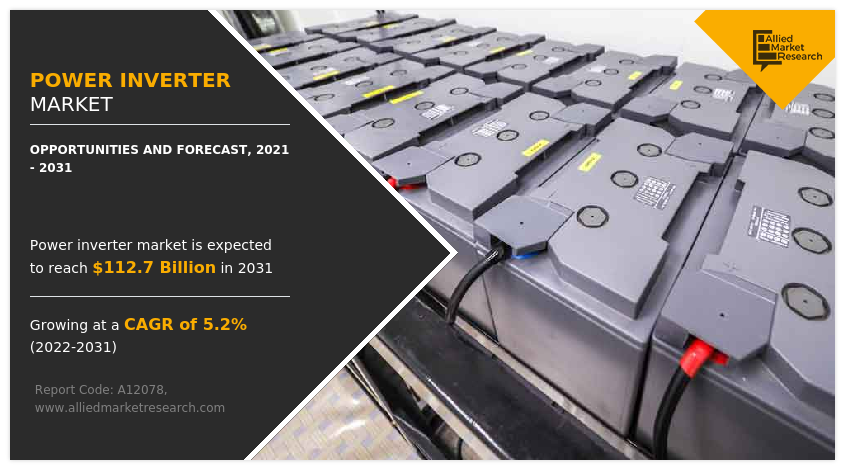
Power inverters are electric devices that transform direct current (DC) into alternating current (AC). Unlike generators, power inverters offer low operating costs and eliminate the inconvenience of using change-over switches. Owing to these characteristics, they are used to operate several tools, household appliances, and other electrical products. Power inverters are available in a variety of sizes, types, and power ranges as per the varied consumer needs and preferences. Some of these variants include modified sine wave power inverters, plug-in grid tie power inverters, and solar power inverters.
An increase in the demand for electricity generated by renewable energy sources has fueled the development of the power inverter. The rapidly rising market share of renewable energy in the power production industry has fueled the need for power inverters. Regulations to support the development of renewable power plants have been changed as a result of the pandemic breakout. A number of objectives have been established by the major industrialized and developing countries to attain zero emissions by 2050, which will support the expansion of the solar, wind, and electric vehicle sectors. The IEA predicts that in 2022, the market for renewable energy will have grown by more than 10%. Renewable energy has seen a promising increase in recent years, as a result, the power sector's global carbon emissions have somewhat decreased. 2019 saw the installation of a record 295 gigawatts of new renewable energy capacity worldwide. The abovementioned factors are expected to drive the power inverter market's global expansion.
A power inverter's price is surprisingly high given how short its lifespan is. Since power inverters normally cost between $1,000 and $2,000, substantial usage of them, especially in renewable energy installations, will require a sizable investment. Energy waste during storage and consumption and an increase in the price of electricity for residential consumers are further disadvantages that hinder market expansion. Long-term use of power inverters causes battery degeneration. Therefore, it is projected that the need for high starting costs and a number of disadvantages related to the usage of power inverters would constrain the growth of the market for power inverters.
A rooftop photovoltaic system, a type of electrical installation setup positioned on the roof, converts solar energy into electricity. These solutions help a building within an existing distribution network meet its energy demands. When AC power is required, a power inverter converts the DC energy generated by PV systems into AC since it is stored in batteries. In order to offset some of the rising costs of power, there is an increasing demand for rooftop solar systems in residential buildings as more household appliances that utilize electricity become accessible. During the projected period, the aforementioned aspect is anticipated to offer lucrative prospects for the power inverter market growth.
As these devices are positioned on a rooftop where temperatures may exceed 140°F, reliability is the solar industry's greatest hurdle and a must for its long-term survival. Solar panel inverters normally need to be replaced at least once throughout the course of the panel's lifetime and typically last between 10 and 12 years. The safe and effective operation of solar panels depends on power inverters. Increased lifespan can benefit a solar system's price, performance, and ability to operate more affordably. During the projected period, the abovementioned factor is anticipated to hamper market growth for power inverters.
The power inverter is the most important part of an electric car, which, under ideal circumstances, transforms battery DC power into AC power for the electric motors. Inverter manufacturers have enhanced inverter capabilities to manage energy, from both sources in response to the rising concern among automakers to optimize energy use in automobiles (i.e., battery and motor). The manufacture of conventional-engine cars is being gradually replaced by hybrid and electric vehicles as a result of increasingly strict pollution regulations across the world. In order to encourage the purchase of electric vehicles in their individual nations, governments have also introduced incentives including reduced vehicle taxes, bonus payments, and premiums. The abovementioned trends and developments will have a positive impact on the market growth.
Asia-Pacific- “Prominent Region” expected to possess highest market growth till 2031
The power inverter market in Asia-Pacific is mainly driven by developing economies such as China, Japan, India, and Australia, as there is rapid growth in the solar energy sectors. This is owing to a large number of key players and the availability of manufacturing facilities in these countries has driven the market. In addition, the rise in urbanization and industrialization in the countries such as China and India have increased the demand for electricity, which further drives the growth of the power inverter market during the forecast period.
The global power inverter market forecast is segmented on the basis of type, application, end use, and region. On the basis of type, the market is segmented into less than 5KW, 5 KW to 100 KW, 100 KW to 500 KW, and more than 500 KW. On the basis of application, the market is segmented into motor drives, wind turbines, rail traction, electric vehicle, UPS, solar PV, and others. In addition, on the basis of end use, the market is segmented into residential, commercial and industrial, and utility. Region-wise, the market is studied across North America, Europe, Asia-Pacific, and LAMEA. Presently, North America accounts for the largest power inverter market share, followed by Asia-Pacific Europe, and LAMEA.
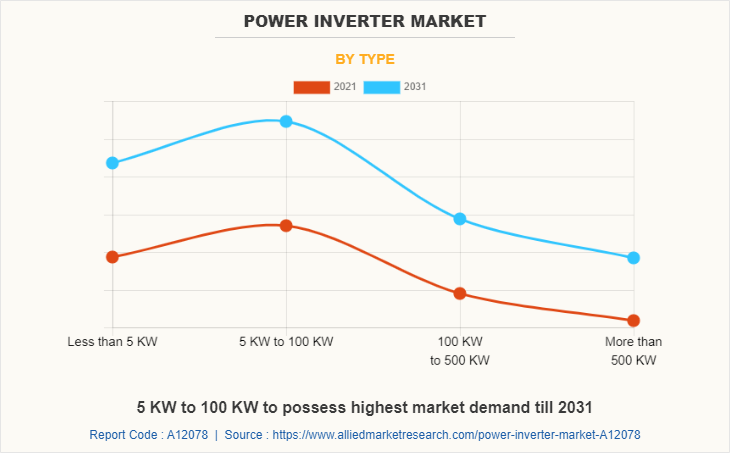
The 5 KW to 100 KW segment dominates the global power inverter market. Power inverters from 5 KW to 100 KW are mostly utilized in rail traction and electric vehicles. An electric car can go around 100 miles on 30 KW of energy, therefore the electric vehicles introduced in 2022 can travel about 400 miles on 100 KW of power. Demand for power inverters will increase as more electric vehicles use 100 KW of power. In addition, it serves as a traction inverter in rail traction, converting AC power into DC power for the DC motors used in locomotives. The growth of the electric vehicle industry has increased the demand for power inverters. This is due to the increased public awareness of the benefits of using electric vehicles for the environment, the existence of government initiatives and policies to encourage the purchase of electric vehicles, and the rise in the price of petroleum fuel globally.
In addition, the continuous electrification of train travel in emerging nations like India has increased the demand for electric locomotives. Opportunities for the market's growth throughout the forecast period have been offered by the market's slow expansion and a rise in investment in India's 100% electrification of rail travel. The above-mentioned factors will provide ample opportunities for the development of the market during the forecast period.
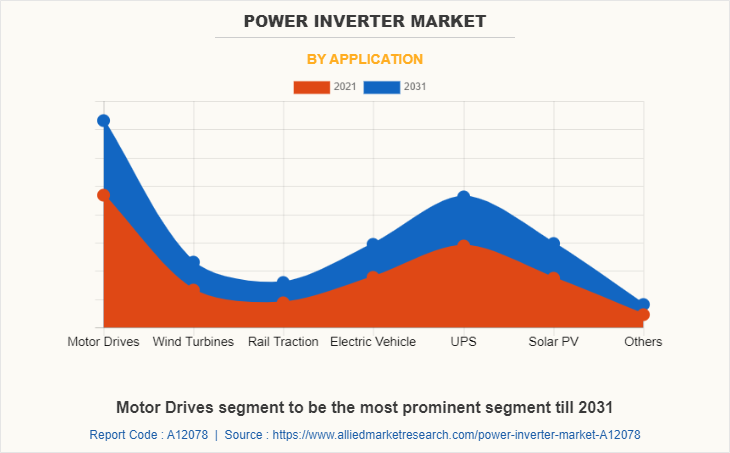
The motor drives segment dominates the global Power inverter market. Motor drives are interchangeable with VFD or VSD since they relate to a drive used to control a motor. The electrical component of the system that regulates the motor's speed is referred to as a variable frequency drive (VFD) or variable speed drive (VSD). The word "drive" is used more broadly to denote mechanical speed-controlling devices. Different industrial operations, including assembly lines, must run at various rates for various goods. When flow adjustment from a pump or fan is required by process circumstances, changing the drive's speed may result in energy savings over alternative flow control methods.
The market is expected to grow as a result of the increasing adoption of connected devices across a variety of industries, including the commercial, industrial, and residential sectors, as well as the rising demand for variable frequency drives (VFDs) due to their advantages, including adjustable speed, dynamic torque control, and energy-saving, from industries like power generation, automotive, and oil & gas. In addition, growing infrastructure investment is driving up demand for HVAC systems, which necessitates finding ways to increase building energy efficiency. This aspect is anticipated to have a beneficial influence on the target market's growth. The above-mentioned factors will provide ample opportunities for the development of the market during the forecast period.
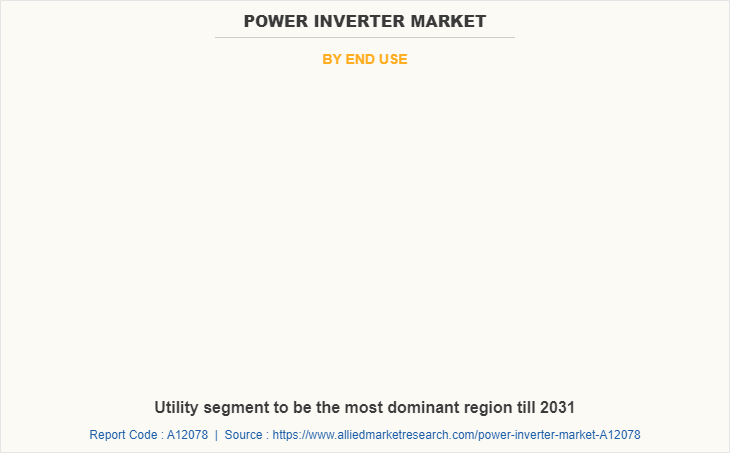
The utility segment dominates the global power inverter market. The role of utilities has increased in the production of solar energy for the main grid as well as in off-grid connections in distant and rural locations. Power inverters are therefore more in demand for utility-scale solar and wind power installations. The market is anticipated to expand at a faster rate over the projected period due to rising investments in utility-scale solar & wind power plants, solar parks, and other solar power-producing facilities. The expansion of the power inverter market will be aided in the coming years by an increase in the number of construction projects, including decentralized solar power plants, rural electrification initiatives, solar power plants on water bodies and roofs, and commercial buildings. The expansion of the power inverter market throughout the period is also fueled by an increase in investments made in developing new technologies to offer affordable renewable power production. A further factor driving the market's expansion is the surge in demand for power inverters in solar power plants based on decentralized installations. The above-mentioned factors will provide ample opportunities for the development of the market during the forecast period.
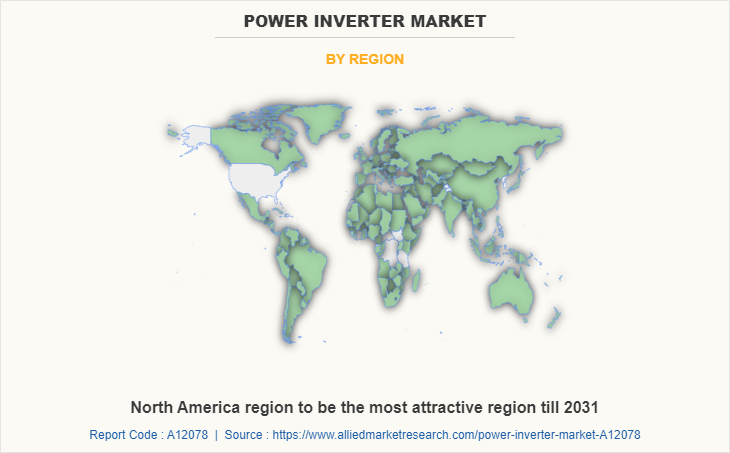
North America segment dominated the global Power inverter market. Due to a rise in the use of renewable energy sources for power generation, the North American power inverter market is expanding significantly. The government and private sector have increased their investments in the construction of solar and wind power facilities as a result of the pressing need to decrease carbon footprints and the strict government rules for energy conservation. In addition, the increased public awareness of solar energy has increased investment in domestic solar power generation. In addition, the government's support programs for EV producers and the availability of commercially viable technologies in this region have increased demand for electric cars, which has had a favorable influence on the market's growth. The above factors drive the growth of the power inverter market in this region during this forecast period.
Impact of Covid-19 on Global Power Inverter Market
During the pandemic, there is a high demand for UPS as most people are working from home, which led to the demand for the UPS system which created a huge demand for the power inverters market. The shutdown of industrial facilities across the globe has led to delays in the construction of solar and wind power plant facilities which have led to a decline in the supply for power inverters during the outbreak period.
The government has invested huge revenue in order to kick-start the stagnant global economy through the construction of renewable power plants. In addition, developing countries such as India and China have invested in the development of environment-friendly power generation and electric cars while gradually reducing fossil fuel imports in order to improve national energy security. In addition, the surge in the sales of electric vehicles in 2021 and 2022 due to increase in awareness among the people regarding the environment and government initiatives have led to a surge in the demand for the power inverter market. The presence of the above-mentioned initiatives and policies will provide lucrative opportunities for the development of the market.
Competitive Landscape
The major companies profiled in this report SolarEdge Technologies, Sungrow, Huawei Technologies Co., Ltd., Enphase Energy, Inc., ABB Ltd., Omron Corporation, SMA Solar Technology AG, Advanced Energy Industries, Inc., Toshiba Mitsubishi Electric Industrial Systems Corporation, and Schneider Electric. An increase in the demand for eco-friendly power generation has led to an increase in investment in solar and wind power plants which led to an increase in the demand for power inverters. Additional growth strategies such as an expansion of storage capacities, acquisition, partnership, and research & innovation in the optimization and improvement in the efficiency and reliability of power inverters have led to attaining key developments in the global power inverter market trends.
Key Developments Shaping the Global Power Inverter Market
- Sungrow is expected to supply Tata Power's 60.56 MWh Battery Energy Storage project in Ladakh.
- SolarEdge announced the launch of SolarEdge home product portfolio at Intersolar Europe 2022. This launch will expand the product portfolio of the company while providing required services to the customer.
- ABB launched a one-stop service with 120KW Solar Inverters in Taiwan. The launch of this service increased the product sales of solar inverters.
Key Benefits For Stakeholders
- This report provides a quantitative analysis of the market segments, current trends, estimations, and dynamics of the power inverter market analysis from 2021 to 2031 to identify the prevailing power inverter market opportunities.
- The market research is offered along with information related to key drivers, restraints, and opportunities.
- Porter's five forces analysis highlights the potency of buyers and suppliers to enable stakeholders make profit-oriented business decisions and strengthen their supplier-buyer network.
- In-depth analysis of the power inverter market segmentation assists to determine the prevailing market opportunities.
- Major countries in each region are mapped according to their revenue contribution to the global market.
- Market player positioning facilitates benchmarking and provides a clear understanding of the present position of the market players.
- The report includes the analysis of the regional as well as global power inverter market trends, key players, market segments, application areas, and market growth strategies.
Power Inverter Market Report Highlights
| Aspects | Details |
| Market Size By 2031 | USD 112.7 billion |
| Growth Rate | CAGR of 5.2% |
| Forecast period | 2021 - 2031 |
| Report Pages | 258 |
| By End Use |
|
| By Type |
|
| By Application |
|
| By Region |
|
| Key Market Players | SolarEdge Technologies, ABB Ltd., Sungrow Power Supply Co., Ltd, Omron Corporation, Advanced Energy Industries, Inc., Schneider Electric, Toshiba Mitsubishi Electric Industrial Systems Corporation, Huawei Technologies Co., Ltd., SMA Solar Technology ag, Enphase Energy, Inc. |
Analyst Review
According to CXO perspective, the global power inverter market is expected to witness increased demand during the forecast period, the surge in the demand for renewable power from solar and wind resources and the increase in the investment to develop the solar and wind power generation infrastructure has a positive impact on the market.
A power inverter is a power electronic device that changes direct current to alternating current the resulting alternating current frequency obtained depends on the particular device employee. Inverters do the opposite of rectifier rectifiers which back originally large electromechanical devices to convert AC to DC. A power inverter can be entirely electronic or maybe a combination of mechanical effects and electronic circuitry.
The increase in the regulations toward fossil fuels and the increase in the cost of crude oil has had a massive impact on the pricing of petroleum products which led to a surge in the utilization of electric vehicles. Furthermore, the increase in awareness among people toward the environment has increased the demand for electric vehicles which led to increasing in the demand for the power inverter market.
This market received a tremendous boost on account of the increasing application of data centers to manage huge data in various sectors. In modern society, most sectors have undergone digitalization and have a great dependency on electronic devices to collect and access information for business purposes and to provide better services to customers. The presence of the demand for this electronic equipment led to the demand for stable electricity during power loss to avoid economic losses is a major factor driving the growth of the power inverter market in UPS applications.
The global power inverter market is analyzed across North America, Europe, Asia-Pacific, and LAMEA. Among the analyzed regions, Asia-Pacific is likely to account for the fastest-growing market throughout the forecast period, followed by North America, Europe, and LAMEA. Asia-Pacific region host some of the fastest developing countries such as China and India. The presence of a huge population and rapid industrialization in these countries has increased the demand for electricity from renewable resources. The presence of demand for renewable energy in this region and government initiatives and investment to develop the solar and wind power plants in this region have led to the presence of significant importance of the power inverter market.
The increase in demand for electric vehicles and increase in focus on renewable energy industries are the key factors boosting the Power inverter market growth.
The increase in the utilization of rooftop solar panels in the residential sectoris the Main Driver of Power inverter Market
Utility based application is projected to increase the demand for Power inverter Market
SolarEdge Technologies, Sungrow, Huawei Technologies Co., Ltd., Enphase Energy, Inc., ABB Ltd., Omron Corporation, SMA Solar Technology AG, Advanced Energy Industries, Inc., Toshiba Mitsubishi Electric Industrial Systems Corporation, and Schneider Electric
The global power inverter market is segmented on the basis of type, application, end use, and region. On the basis of type, the market is segmented into less than 5KW, 5 KW to 100 KW, 100 KW to 500 KW, and more than 500 KW. On the basis of application, the market is segmented into motor drives, wind turbines, rail traction, electric vehicle, UPS, solar PV, and others. In addition, on the basis of end use, the market is segmented into residential, commercial and industrial, and utility. Region-wise, the market is studied across North America, Europe, Asia-Pacific, and LAMEA.
The market value of Power inverter in 2031 is expected to be $112.7 billion
The surge in the sales of electric vehicles in 2021 and 2022 due to increase in awareness among the people regarding the environment and government initiatives have led to a surge in the demand for the power inverter market. The presence of the above-mentioned initiatives and policies will provide lucrative opportunities for the development of the market.
Loading Table Of Content...



